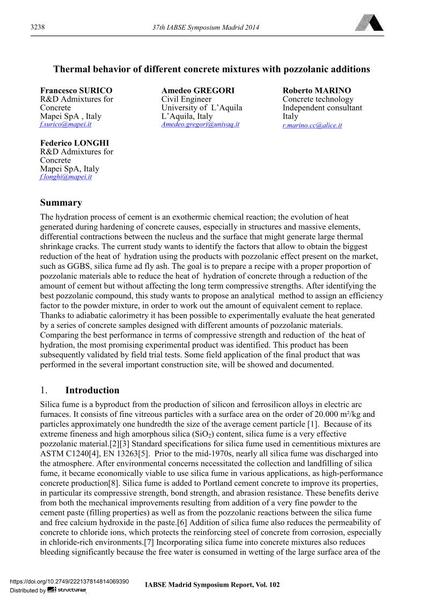Thermal behavior of different concrete mixtures with pozzolanic additions

|
|
|||||||||||
Bibliographic Details
| Author(s): |
Francesco Surico
Amedeo Gregori Roberto Marino Federico Longhi |
||||
|---|---|---|---|---|---|
| Medium: | conference paper | ||||
| Language(s): | English | ||||
| Conference: | IABSE Symposium: Engineering for Progress, Nature and People, Madrid, Spain, 3-5 September 2014 | ||||
| Published in: | IABSE Symposium Madrid 2014 | ||||
|
|||||
| Page(s): | 3238-3245 | ||||
| Total no. of pages: | 8 | ||||
| Year: | 2014 | ||||
| DOI: | 10.2749/222137814814069390 | ||||
| Abstract: |
The hydration process of cement is an exothermic chemical reaction; the evolution of heat generated during hardening of concrete causes, especially in structures and massive elements, differential contractions between the nucleus and the surface that might generate large thermal shrinkage cracks. The current study wants to identify the factors that allow to obtain the biggest reduction of the heat of hydration using the products with pozzolanic effect present on the market, such as GGBS, silica fume ad fly ash. The goal is to prepare a recipe with a proper proportion of pozzolanic materials able to reduce the heat of hydration of concrete through a reduction of the amount of cement but without affecting the long term compressive strengths. After identifying the best pozzolanic compound, this study wants to propose an analytical method to assign an efficiency factor to the powder mixture, in order to work out the amount of equivalent cement to replace. Thanks to adiabatic calorimetry it has been possible to experimentally evaluate the heat generated by a series of concrete samples designed with different amounts of pozzolanic materials. Comparing the best performance in terms of compressive strength and reduction of the heat of hydration, the most promising experimental product was identified. This product has been subsequently validated by field trial tests. Some field application of the final product that was performed in the several important construction site, will be showed and documented. |
||||
